Rebuilding Pakistan: how much should rich nations help?
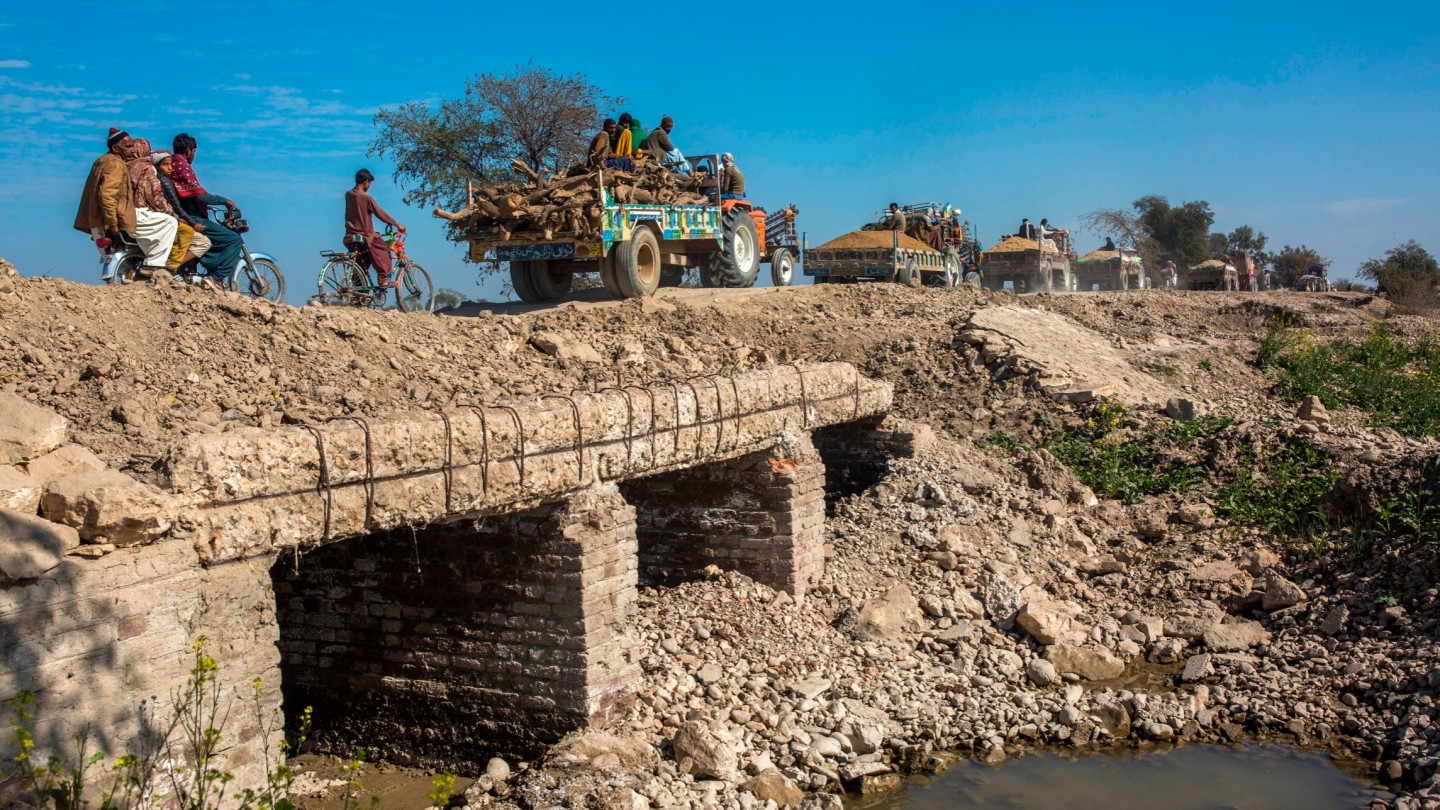
Roula Khalaf, Editor of the FT, selects her favourite stories in this weekly newsletter.
After months of living in a camp for displaced people, Rajab and Jado are rebuilding a home that they already know may not last.
The married couple haul wheelbarrows of mud through barren fields and stagnant water, sombre reminders of the historic floods that last year washed away their village of Khoundi in southern Pakistan. They daub it on to the wall surrounding their half-built brick bungalow and makeshift tarpaulin tents.
“We don’t have enough money to buy cement or proper bricks,” says Rajab, whose family of 12 is eating one meal a day. “We know that this will go down. But what can we do?”
Pakistan is still reeling from the floods that inundated the country of 220mn people between June and October. The floods, exacerbated by climate change, caused an estimated $30bn in damage and economic loss, destroyed millions of homes and farms and pushed the country — already struggling financially — to the brink of default.
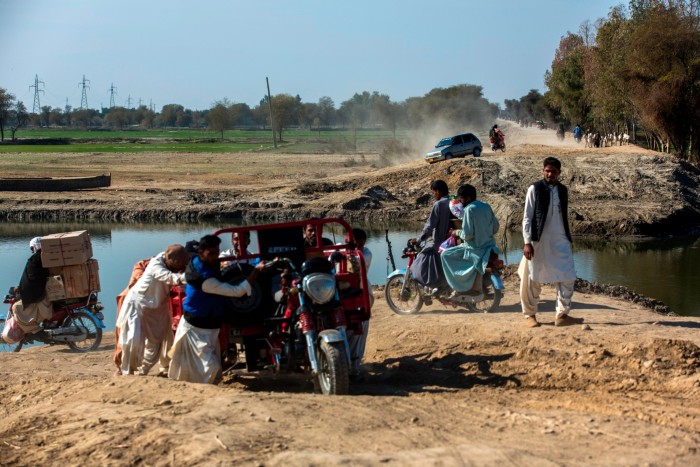
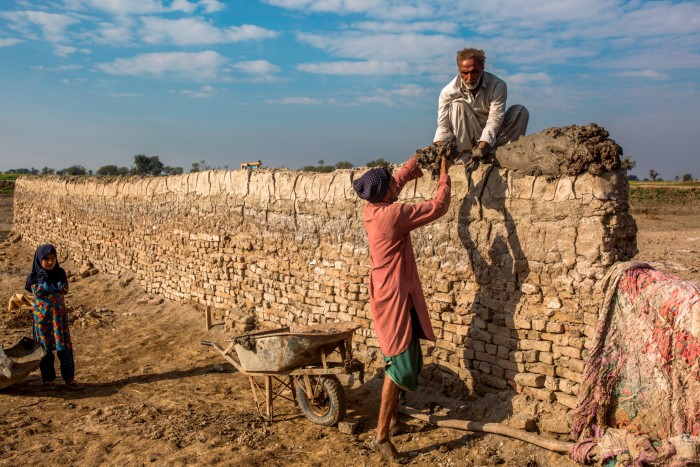
As it rebuilds, Pakistan will be a test case for an issue of growing global importance: how vulnerable countries, many of which have contributed little to global greenhouse gas emissions, recover from the havoc wreaked by increasingly frequent and extreme weather events — and how much polluting rich nations should help them.
These questions dominated the COP27 climate summit in November, at which nearly 200 nations agreed to the creation of a fund to finance the “loss and damage” caused by global warming.
With details of how that fund will work still being thrashed out by global negotiators, Pakistan has independently raised $9bn in loans and other financing at a conference in Geneva in January to pay for recovery, reconstruction and climate resilience.
The success or failure of its reconstruction plan, which the Pakistan government expects to take five to seven years, could influence the appetite of donors to direct financial support to countries or small island nations bearing the brunt of a warming planet.
But channelling climate financing to Pakistan — and ensuring it is well spent — is complicated, not least because of the country’s perennial political instability and economic mismanagement.
Pakistan relies on regular international bailouts, with prime minister Shehbaz Sharif currently trying to unlock the next $1bn tranche of a $7bn IMF loan programme that analysts say the country needs to avoid bankruptcy. Its foreign reserves have fallen to about $3bn, less than one month’s worth of imports.
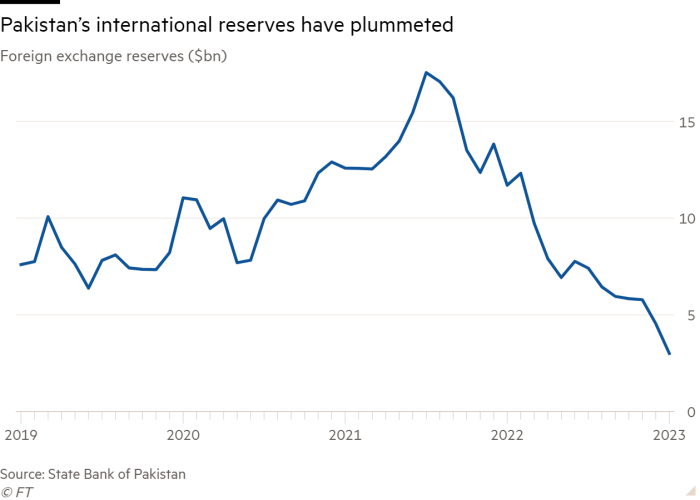
Beyond the long-term challenge of tackling climate-change, Pakistan is facing an overwhelming list of immediate challenges. There are growing shortages of food, fuel and other basic essentials. Poverty is rising and millions of people in flood-hit areas are going hungry, out of school or displaced. With the next rainy season just a few months away, people like Rajab and Jado — beneficiaries of a pilot scheme run by Islamic Relief and the United Nations Development Programme — do not have the luxury of time.
Pakistani authorities and donors are also trying to look further ahead and direct funds into projects designed to withstand future climate shocks. Examples range from better early warning systems to, in the case of the Khoundi pilot, toilets built on elevated plinths to make it harder for contamination to spread during floods.
“The challenge is to start implementing a long-term approach and strategy to climate risks,” says Alexandre Magnan, senior research fellow at the Institute for Sustainable Development and International Relations. “It is the responsibility of the national decision makers and probably also of regional and international partners to push for that . . . We really need examples that show that it is possible.”
Adapting to extreme weather
The world has already warmed by about 1.1C since pre-industrial times, and any additional increase will bring more frequent and extreme weather events, scientists warn. Many of them will occur in developing countries that lack the resources to build back after floods, fires or hurricanes.
Whether — and how — rich countries should help poorer nations cope with such destruction remains an open question. The world’s most advanced economies have long resisted the notion of providing “loss and damage” financing because they worry doing so could constitute a tacit admission of guilt.
That position became untenable in 2022, partly due to the pressure generated by Pakistan’s floods. Animesh Kumar, head of the UN’s Office for Disaster Risk Reduction in Bonn, says it was “an eye-opener” that laid bare the world’s lack of preparedness for the onslaught of climate crises coming down the line. A study by the World Weather Attribution group estimated that the country’s monsoon rains last year were up to 50 per cent more intense than they would have been without climate change.
At the peak of the disaster, 33mn people and more than half of the country’s districts were affected. In Sindh, the worst-hit province where Khoundi is located, the majority of the rice, cotton and sugar cane crops were lost. The floods knocked at least 2.2 per cent off Pakistan’s gross domestic product last year, the World Bank estimated.
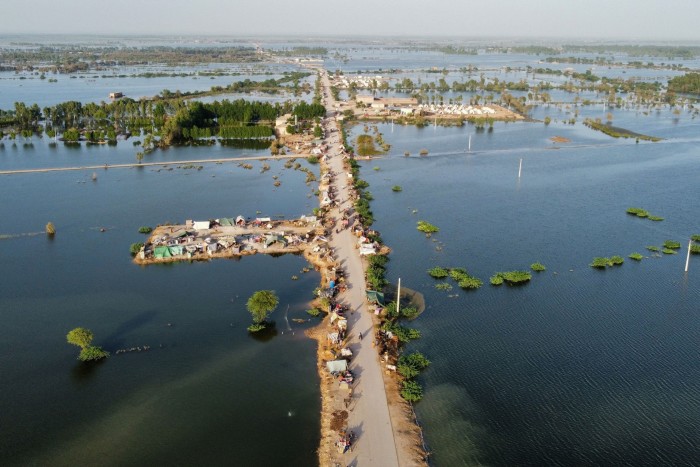
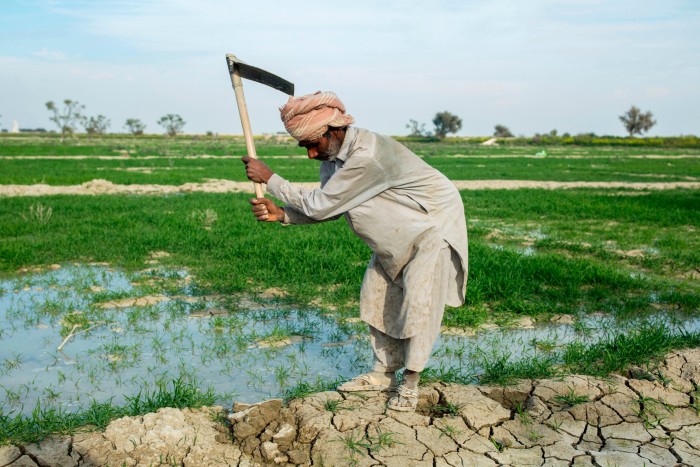
The loss and damage fund agreed at COP 27 was a breakthrough — although finalising which nations pay into it is a subject that will be wrestled over in the coming months. A decision is unlikely to be made this year. Countries, including EU members, are anxious that others such as China and Saudi Arabia — which are technically classified as developing countries under the UN system despite growth over the past 30 years — contribute their share.
Many countries say it cannot be governments alone footing the bill and are calling for multilateral development banks to provide more support to impoverished nations suffering from climate shocks. The World Bank, whose president abruptly announced his resignation in February, is under particular pressure to overhaul its operations and integrate climate into its development work.
Another hurdle is quantifying the scale of expected destruction. Researchers at the Basque Centre for Climate Change have estimated that developing countries could suffer losses of $580bn in 2030. During the first half of 2022 alone, there were at least 187 disasters from natural hazards across 79 countries that caused more than $40bn worth of damage, according to the Em-Dat international disasters database.
Without more financial help, developing countries say they risk being caught in a cycle of disasters and poverty. At the World Economic Forum in Davos in January, Pakistan’s climate change minister, Sherry Rehman, warned of “recovery traps”. Rebuilding takes time and money, she said, and “by the time you do that the next crisis is on you”.
But how to distribute recovery money fairly is a politically fraught discussion. “Will funding go to the people who’ve lost the most or to the people who didn’t have anything to lose originally?” asks Daniel Clarke, director of the Centre for Disaster Protection.
Pakistan estimates that it needs about $16bn for recovery, more than half of which it secured in Geneva from international donors including the Islamic Development Bank, World Bank and USAID. “The financial pledges were much more than we thought,” says Knut Ostby, the UN Development Programme’s regional representative in Pakistan. “Now is the time to follow up.”
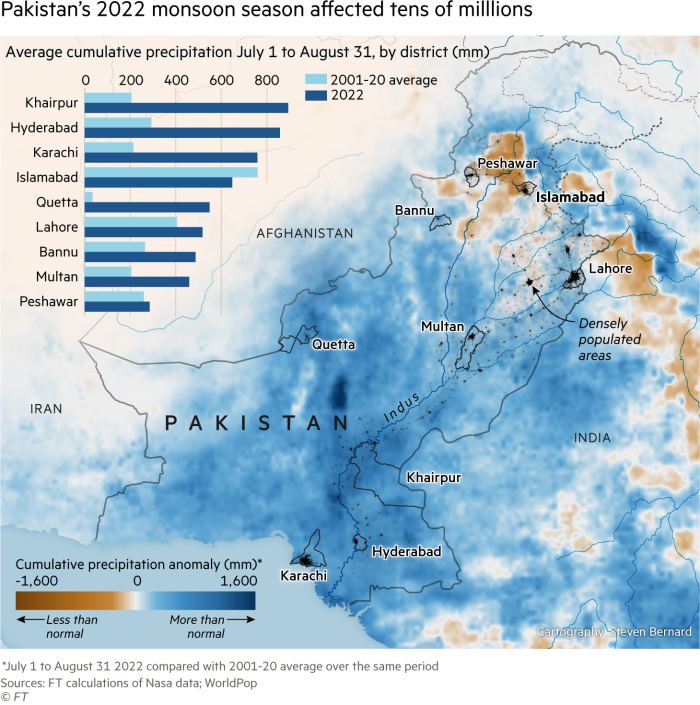
Much of the money will come in the form of loans and they are tied to the financing of specific projects rather than budgetary support. The World Bank, for example, plans to lend about $2bn to rebuild houses and improve irrigation among other projects in Sindh.
Because the speed at which financing arrives varies from donor to donor, it can lead to frustrations and crucial delays for the communities that need it most.
In the district of Dadu, where Khoundi is located, large-scale reconstruction work is yet to begin. The village of Ibrahim Chandio has been reduced to rubble. Its former residents now live in tents nearby, with little expectation of that changing anytime soon. Displacement is pushing them into more precarious situations, as farmers struggle to grow crops on the inundated soil and families run low on funds for food.
Syed Murtaza Ali Shah, the district’s most senior local official, says the authorities want to reinforce a number of roads and embankments to prevent them breaking, but they don’t yet have the funds to do so. “The next monsoon could be heavier than this one,” he says. Work is “a stop-gap arrangement . . . Somebody is building 50 houses, someone else is trying to build 10 houses with whatever funds are available.”
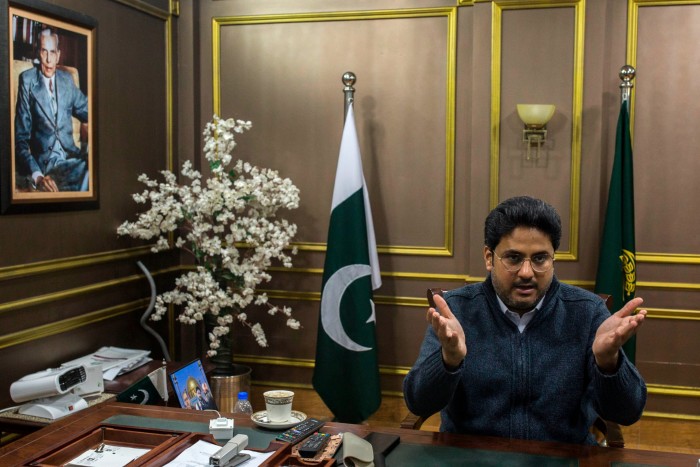
Some experts like Ali Tauqeer Sheikh, a climate change consultant in Islamabad, are wary of “pledged” funds, which he says often recount money committed for existing programmes.
Disbursements are also subject to crippling, sometimes permanent, delays, as projects conceived on paper struggle to get off the ground in practice.
While Pakistan’s fundraising is “a very important building block”, Sheikh says, “in real life, the answer [to where the money goes] will be complex”.
Crisis after crisis
Even before the floods, Pakistan was already in crisis.
Inflation has soared, with a price index of everyday items last week rising 41 per cent year on year. With upcoming elections, Sharif’s government is engaged in toxic political squabbling with rival Imran Khan, who was ousted as prime minister last year and recently survived an assassination attempt. The threat of violent extremism is rising, with a mosque bombing in January killing about 100 people.
Sharif’s government argues that the floods mean it should be exempt from some of the austerity conditions the IMF wants to see implemented to restart lending, which range from raising taxes to cutting subsidies. The conditions, the NGO Human Rights Watch has warned, “hit hardest on the people already most heavily affected”.
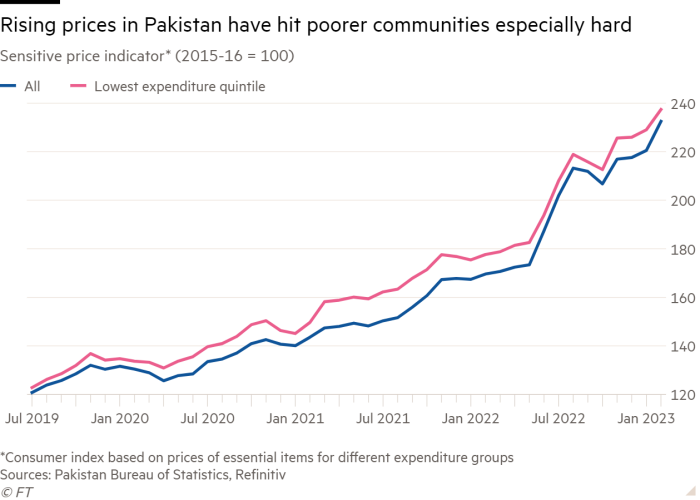
“No country has taken the hit like Pakistan of a $30bn climate disaster,” says Ahsan Iqbal, the country’s planning minister. “There has to be this understanding that the economy does not need more shocks.”
Yet critics at home and abroad say many of Pakistan’s woes are self-inflicted. A succession of weak governments have prioritised short-term, politically motivated spending, they say, while promoting import-friendly policies that disproportionately benefit the wealthy. The authorities have also cracked down on NGOs, which critics say has hobbled civil society and limited its ability to respond to crises.
The country’s political system is also destabilised by its powerful army, which has long exerted control behind the scenes, and Pakistan ranks 140 out of 180 on Transparency International’s corruption perception index.
“Ours is a very elite-captured society,” says Miftah Ismail, who was finance minister before resigning in September. “The elite is happy with the status quo . . . Politics is all about everybody wanting to be in power, at great cost to the nation.”
Pakistan’s government has acknowledged the need for institutional reforms in its blueprint for reconstruction. Examples include improving building regulations to prevent hazardous construction in flood plains, as well as creating a third-party monitoring system to ensure the funds are well spent.
Yet Sharif’s days in office may be numbered, with many analysts predicting Khan would win if elections later this year were a free contest. While Khan has professed the importance of climate resilience, long-term plans like these have consistently struggled to survive the country’s frequent and turbulent power transitions.
“Money alone is not enough,” says Germany’s climate envoy Jennifer Morgan. “It’s crucial that governance structures and processes in the recipient countries exist to ensure that the money is going to reach the people who need it the most. That’s a key question in loss and damage: how do we make sure that funds actually get to the local level.”
Some experts within Pakistan are not optimistic. Dysfunctional relationships between rival federal, provincial and district-level governments could prevent funds from reaching projects and making real change. “Will these funds touch the ground? [And] to what extent are . . . [local] government structures resilient enough to enable the flow of funds in a transparent fashion?” says Nausheen Anwar, an urban planning expert at the Institute of Business Administration in Karachi.
There is also the risk that poorly planned projects could inadvertently cause future problems, which some researchers refer to as “maladaptation”. In February, local activists in Badin, in Sindh, organised a conference to discuss the decades-old Left Bank Outfall Drain project, part financed by the World Bank, which they said had made the flooding worse after it burst. An independent inspection in 2006 identified numerous “shortcomings” in the $1bn project.
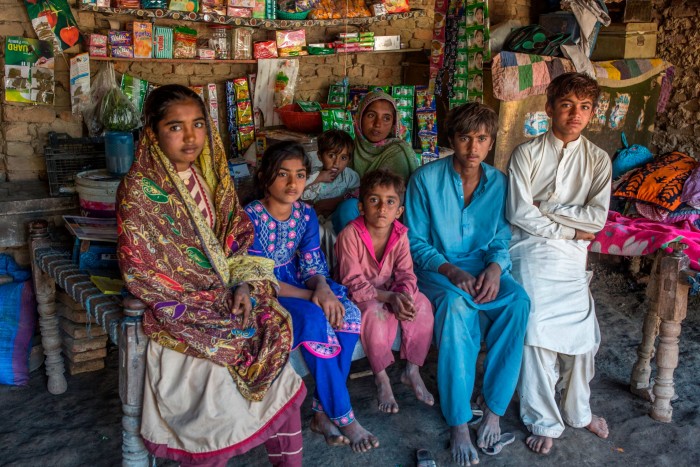
Nowhere is the disillusionment greater than in flood-hit areas. In Khoundi, the village’s only government school has been a ruin since 2010, another year of disastrous flooding in the region.
Imdad Ali, a 38-year-old teacher, holds classes for handfuls of students on a bench outside. About 80 children are enrolled, but only 15 to 20 attend each day, locals say, with others going to a locally run NGO school or not studying at all. At 23mn, Pakistan has one of the world’s second-highest population of children out of school.
Sindh is the base of the Bhutto dynasty, whose Pakistan People’s Party is in the country’s ruling coalition. But people have little faith in them or any of the other parties. “There are no facilities, no chairs, no tables,” Ali says. “We have asked several times for help. But it doesn’t come.”
An academic paper about the 2010 recovery effort, published in the International Journal of Disaster Resilience in the Built Environment in 2020, concluded that “the local administration returned to day to day operations with no community resilience or long-term recovery related programmes.”
Sobia Kapadia, an architect who helped with the recovery effort a decade ago, says planning this time “requires a resolve for change, and a complete [overhaul] of existing systems” to change how local and federal authorities interact with each other, as well as shifting the balance of power and resources.
“Unless and until you do things at the ground level with the community, things will not change,” she adds.
Few locals believe that will happen. Some laugh bitterly when asked whether they expected their hometowns to become resilient to climate shocks.
Nazeer Hussain, a 43-year-old wheat miller in Khoundi, says the country’s leaders only care about securing power for themselves. “We have been hearing in the media that the government has been having meetings [to raise money to] build homes and shelters,” he adds. “But there is zero chance of that.”
Data visualisation by Keith Fray
Comments